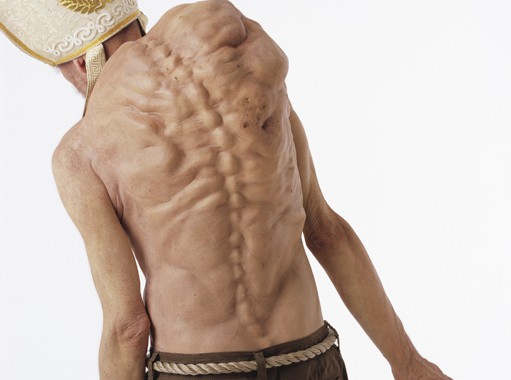TRANSFORMATION CAN BE PERILOUS TERRITORY FOR AN ARTIST TO navigate, and to be authentic necessarily involves pain, either psychic or physical. Daniel Joseph Martinez’ newest exhibition, the first in Los Angeles in five years, displays a fiercely compelling and forceful visual lexicon drawn from the artist’s personal associations with body dysmorphia, and which combines images of the physical body with overtly politically-charged iconography including the Statue of Liberty and various religious artifacts.
Working with large-scale photographic images, sculptural works, and found objects including a police riot shield, neon signage and a bullhorn used largely by street preachers, Martinez communicates a rapidly unraveling human dystopia as everywhere people struggle to express their own identities despite the fact that space is getting tighter and money more scarce.
In the photographs, the artist transgresses against his own body, sporting a grotesque hunchback and positioning himself at various turns on a prayer rug, or wearing a papal tiara and a mask that has a vague and unsettling resemblance to Richard Nixon. In several images his tattooed arms display the holiest Hebrew prayer: “Hear Israel, God is one,” written in Latin, Hebrew and Arabic, further exemplifying the body as a politicized public space where pain is often invisible. But pain is a universal human experience around which entire civilizations have rallied and here Martinez implicates the entire living world. Each photograph leans against the gallery wall, yet the content of each is painfully aggressive. We are reminded of artists like Coco Fusco, Cildo Meireles and Ken Gonzalez-Day who have charted similar territories, recalibrating history with all its itinerant ugliness and violence, conflating public and private spaces to reflect a more authentic experience of the world.
Martinez’ immense sculptural work titled Who Killed Liberty, Can You Hear That, It’s The Sound Of Inevitability, The Sound Of Your Death (2012) literally pierces the gallery wall leading from the main space into the adjacent project room. It operates as a “fallen angel,” revealing to us our own human shortcomings and inadequacies. A mirror, affixed to the bottom of the massive work and in which we cannot help but find our own faces, is also angled awkwardly toward the ceiling, further skewing our perceptions of ourselves. Lady Liberty appears thus truncated, profoundly damaged and crumbling as though the weight of today’s fractured political climate were dragging her down. In addition, a gold-plated multiple edition of the statue further collapses “liberty” with commodification, as though our basic human, and supposedly inalienable rights, i.e., life, liberty and the pursuit of happiness, can be bought and sold at a price, thus completely nullifying their original meaning.
Ultimately, Martinez suggests that democracy and all it once stood for is broken in much the same way our collective human consciousness and our bodies are ailing, yet we are trapped inside them and all we have created. Liberty is in the final devastating throes of her own death. This politically charged symbol appears to be languishing in her own liminal and uncertain transformation, and perhaps all of us on the planet are headed toward the same ambiguous, painful end.
– Eve Wood


